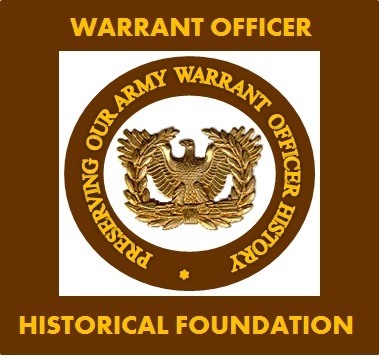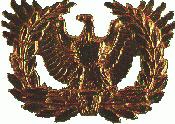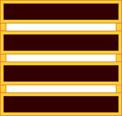 Warrant
Officer Historical Foundation
Warrant
Officer Historical Foundation
formerly
Warrant
Officers
Heritage
Foundation
A Non-Profit
501 (c) (3) Public
Charity
Preserving Army Warrant
Officer History ™
(Many files throughout this web site are Portable Document Format (PDF)
files.
If you cannot open a PDF file
download the current version of
the free Adobe reader.)
History of
U. S. Army Warrant Officer Insignia
The predecessor of the warrant officer was the Army Field Clerk and the Field Clerk, QMC, both authorized by Act of Congress in August 1916. Special Regulation 41 dated December 19, 1917 stated: “Army Field Clerks and Field Clerks, Quartermaster Corps, will wear the same uniforms as officers, omitting all insignia of rank and the brown braid on the cuff of the service coat. Cord for service hat to be of silver and black silk intermixed.
As a result of the Appropriations Act of July 9, 1918, the rank and grade of warrant officer was officially established. War Department Bulletin 43 dated July 22, 1918 stated: “..in the Coast Artillery Corps of the Regular Army a service to be known as the Army Mine Planter Service, which shall consist, for each mine planter in the service of the United States, of one master, one first mate, one second mate, one chief engineer, one second assistant engineer and one assistant engineer, who shall be warrant officers appointed by holding their office at the discretion of the Secretary of War.” Although no warrant officer rank insignia was authorized, a sleeve insignia to identify the job specialties was created by War Department Circular 15 on January 17, 1920. The sleeve insignia had a three-bladed propeller or foul anchor above the braid as shown below. This insignia remained in effect until the Mine Planter Service was abolished on June 30, 1947.
|

|

|

|

|

|

|
|
Chief
Engineer
|
Master
|
Assistant
Engineer
|
First Mate
|
Second Asst. Engineer
|
Second
Mate
|
The Army Field Clerks and the Quarter Master Corps Field Clerks were officially designated as warrant officers as a result of Act of Congress, June 4, 1920 and implemented in War Department Bulletin 25 dated June 9, 1920. These warrant officers wore the same uniform as the Army Mine Planter Service warrant officers except they did not wear the sleeve braid.
Warrant officers were provided with an insignia of identification on May 12, 1921, which also served as their insignia of grade except warrant officers of the Army Mine Planter Service (Coast Artillery Corps.)

Eagle Rising Warrant Officer Insignia
(see Origin of the Eagle Rising)
Public Law 230, 77th Congress created two grades of warrant officer on August 21, 1941. On September 4, 1942, Change 1 to AR 600-35 authorized the insignia of grade for warrant officers other than Army Mine Planter Service. The regulation described the insignia for chief warrant officer as a gold bar 3/8 inch (0.95cm) in width and 1 inch (2.54cm) in length with rounded ends, brown enamel on top with a longitudinal center stripe of gold 1/8 inch wide (0.32cm). The insignia for warrant officer junior grade was a gold bar 3/8 inch (0.95cm) wide and 1 inch (2.54cm) long, rounded at the ends with brown enamel on top and a latitudinal center of gold 1/8 (0.32cm) inch wide. War Department Circular 366, November 7, 1942, established a flight officer with the insignia the same, as the warrant officer junior grade except the enamel was blue. The position of Flight Officer was subsequently abolished in 1945.
|

|

|

|
|
Chief Warrant Officer
|
Warrant Officer Junior Grade
|
Flight Officer
|
In Circular 118 dated May 9, 1947, the War Department announced it was seeking legislation to authorize four grades of warrant officers in the Army. The insignia were gold with brown enamel. There were four bars for Chief Warrant Officer, three bars for Senior Warrant Officer, two bars for Warrant Officer First Class, and one bar for Warrant Officer. Samples of the insignia were approved on November 28, 1947 and titles changed to Chief Warrant Officer, Warrant Officer First Class, Warrant Officer Second Class and Warrant Officer Third Class. Legislation establishing the four grades was approved on October 12, 1949; however, the insignia was not implemented.
|

|

|

|

|
|
Chief Warrant Officer
|
Warrant Officer
First Class
|
Warrant Officer
Second Class
|
Warrant Officer
Third Class
|
On August 17, 1954, the Assistant Secretary of Defense advised the Assistant Secretary of the Army that the other military services concurred in new proposed designs. The new designs authorized by AR 670-5 dated September 20, 1956 were as follows:
|
Chief Warrant Officer
W4
|
Chief Warrant Officer W3
|
Chief Warrant Officer W2
|
Warrant Officer
W1
|
As a result of a study to improve the warrant officer insignia of grade to make it easier to identify the grade, new insignia was approved by the Chief of Staff Army on June 10, 1970 with an effective date for wear of July 1, 1972. Based on anticipated change in legislation to authorize two additional warrant grades, new insignia for W5 and W6 were also approved by the Chief of Staff in 1970. The insignia was developed but never authorized for wear for W5 and W6. The design of the insignia is as follows:
|

|

|
|
CWO W6
|
CWO W5
|
|

|

|

|

|
|
CWO W4
|
CWO W3
|
CWO W2
|
WO W1
|
Master Warrant Officer (W4) insignia was approved by the Chief of Staff on April 8, 1988 to designate certain CWO W4 as master warrants. The appointment to Master Warrant Officer required completion of the Warrant Officer School at Fort Rucker. The first class graduated on December 8, 1988 and class members were authorized to wear the insignia. With passage of the Warrant Officer Management Act on December 5, 1991, the grade of CW5 was established. On March 28, 1991, the Chief of Staff approved continued use of the Master Warrant Officer insignia for Chief Warrant Officer W5.

Master Warrant Officer W4 and Chief Warrant Officer W5 (1988 - 8 July 2004)
A request was submitted by the Army Training and Leader Development Panel-Warrant Officer (ATLDP-WO) to wear the CW5 insignia approved in 1970 by the former Chief of Staff, Army, and this request was approved by General Peter J. Schoomaker, The Chief of Staff, on 16 December 2003.
The ATLDP-WO also requested authorization for Warrant Officers to wear Branch-specific insignia and colors in lieu of the current Warrant Officer insignia and colors. This request was approved by The Chief of Staff on 24 February 2004. The request was submitted and approved as a first step towards the full integration of Warrant Officer recruiting, accession, education and management into the branch-based systems of the larger officer corps. Additionally, the increasingly joint nature of operations with the Department of Defense and the expanded use of the most senior warrant officers in joint operations validated the need to standardize CW5 rank insignia among all the services that employ them. The effective date for wear of the new CW5 insignia and branch-specific insignia and colors was 9 July 2004 to coincide with the 86th anniversary of the Warrant Officer Corps.
|

|
|
Chief Warrant Officer W5
|
(Note: Unlike the Army, the Marine Corps and the Navy adopted the CWO W5 insignia shown above versus the MWO insignia worn by the Army Warrant Officers from from March 1991 until 8 July 2004.)
On 9 July 2004, new Chief Warrant
Officer 5 insignia (above), wear of Army Officer Branch insignia and branch colors, wear of "Eagle Rising" in Warrant Officer Candidate School
& Warrant Officer Basic Courses were uniform changes for Army Warrant Officers -
see
All Army
Activities Message 042-2004.pdf. This in fact
relegated the brass Eagle Rising Warrant Officer Corps insignia
to a part of the Corps History. (see
also Army Branch Insignia and Branch Colors)
(This History of Army Warrant
Officer Insignia is based in part onThe Institute of Heraldry, U. S.
Army History of Warrant Officer Insignia.)
Make a Donation using the secure USAWOA Interactive Portal.
No donation is too small!
A
ll Donations, Grants, and Bequests are Tax Deductible within the limits prescribed by law.
See also "10 Tips for Deducting Charitable Contributions."
|
Top |
Home |
Site Map |
Feedback |
Updated 3/28/2104